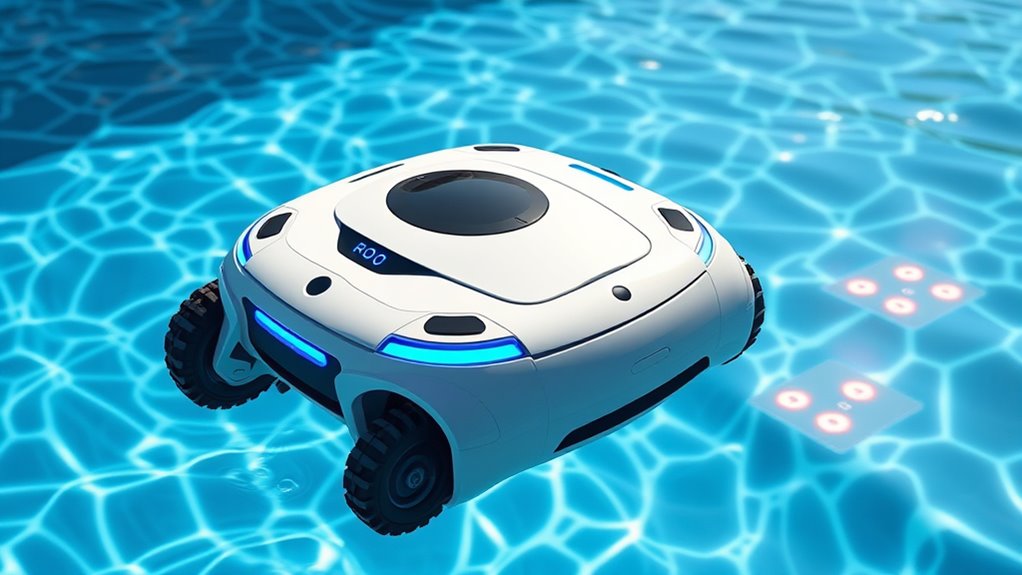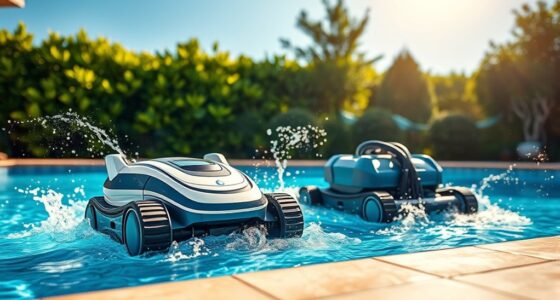AI and smart technology in robotic pool cleaners allow you to enjoy effortless, thorough cleaning. These devices navigate autonomously, mapping your pool and avoiding obstacles with sensors. They adapt to changing water conditions, optimize their routes, and identify when maintenance is needed. This smart integration guarantees better coverage, longer device lifespan, and less supervision. By incorporating advanced features, these cleaners make pool care simpler and more reliable—keep exploring to discover how they transform your cleaning experience.
Key Takeaways
- AI enables autonomous mapping and obstacle avoidance for efficient, independent pool cleaning routes.
- Sensor integration allows real-time obstacle detection, debris recognition, and adaptive adjustments.
- Smart technology enhances efficiency by reducing overlaps, conserving energy, and ensuring thorough coverage.
- Seamless automation combines sensor data with navigation, simplifying setup and maintenance.
- Future trends include smarter systems that optimize overall pool management and prolong device lifespan.

Advancements in AI and smart technology are transforming robotic pool cleaners, making them more efficient and user-friendly than ever before. One of the most significant innovations driving this change is autonomous navigation. With autonomous navigation, your robotic cleaner can independently map the pool, identify obstacles, and plan the most efficient cleaning routes without your constant input. This means it moves smoothly around stairs, ladders, and other fixtures, ensuring no area is missed. Instead of random, haphazard movements, these cleaners now follow intelligent patterns that maximize coverage in less time, saving you both effort and energy. You no longer need to supervise or reposition your cleaner manually, as it adapts dynamically to the pool’s layout.
Autonomous navigation allows robotic pool cleaners to map pools, avoid obstacles, and clean efficiently without manual supervision.
Sensor integration plays a vital role in enhancing this autonomous navigation. Modern robotic pool cleaners are equipped with a variety of sensors—such as infrared, ultrasonic, and proximity sensors—that provide real-time data about their surroundings. These sensors help the cleaner detect obstacles, walls, and debris, adjusting its path instantly to avoid collisions and ensure thorough cleaning. This integration provides a level of precision that was previously unattainable, allowing the robot to respond to changes in debris levels or water conditions on the fly. For example, if the cleaner detects a large pile of leaves, it can prioritize that area or switch to a different cleaning mode, optimizing the process. The use of AI algorithms further enhances their ability to adapt to complex pool layouts. Moreover, the sensors enable real-time data collection, which improves the robot’s efficiency and effectiveness. This sensor technology also helps in maintaining the longevity of the device by preventing unnecessary strain or damage.
The combination of autonomous navigation and sensor integration makes these smart devices remarkably adaptive. They can recognize when they’re stuck or need maintenance, alerting you through companion apps or onboard indicators. This proactive approach reduces the chances of damage and prolongs the lifespan of your cleaner. Additionally, these features work together to improve energy efficiency; the cleaner avoids unnecessary overlaps and redundant movements, conserving power and extending runtime. It also means you get a more consistent clean, as the robot intelligently covers every inch of your pool without missing spots or wasting time.
As you set up your robotic pool cleaner, you’ll appreciate how seamlessly these technologies work together. You simply turn it on, and it takes over entirely, navigating your pool with minimal input. Sensor integration ensures it reacts smartly to changing conditions, while autonomous navigation guarantees thorough coverage. This level of automation not only simplifies pool maintenance but also ensures your pool stays sparkling clean with less effort on your part. In essence, these innovations are transforming your experience, making pool cleaning smarter, faster, and more reliable than ever before. Moreover, understanding the importance of air quality in related systems highlights how integrated smart features can optimize overall performance and longevity.
Frequently Asked Questions
How Do Ai-Driven Pool Cleaners Adapt to Different Pool Shapes?
You might wonder how robotic pool cleaners handle various pool shapes. They adapt by scanning the pool layout, recognizing obstacles, and adjusting their cleaning patterns accordingly. This guarantees thorough coverage regardless of irregular shapes or tight corners. Additionally, they monitor water chemistry, optimizing their cleaning cycles to prevent issues like algae buildup or chemical imbalance. This smart adaptability keeps your pool clean and well-maintained, no matter its design or condition.
What Safety Features Are Integrated Into Smart Robotic Pool Cleaners?
They say safety comes first, and smart robotic pool cleaners are no exception. You’ll find safety protocols like obstacle detection, which prevent accidents, and emergency shutdown features that stop the cleaner if needed. These safety features protect you and your pool, ensuring smooth operation while reducing risks. When you prioritize safety, you enjoy a clean pool without worry, making your swimming experience safer and more enjoyable.
Can AI Improve Energy Efficiency in Robotic Pool Cleaning?
You can see that AI has the potential to enhance energy efficiency in robotic pool cleaning by reducing energy consumption through smarter operation patterns. It optimizes cleaning routes and schedules, ensuring the device works only when needed and avoids unnecessary energy use. This cleaning optimization not only saves power but also prolongs the cleaner’s lifespan, making your pool maintenance more efficient and eco-friendly.
How Do Smart Sensors Detect and Navigate Around Obstacles?
You might think obstacle detection is simple, but smart sensors make navigation a breeze. They actively scan the pool’s environment, detecting obstacles with precision. Through sensor navigation, your robotic cleaner avoids bumps and gets the job done efficiently. It’s amusing how these tiny sensors work tirelessly, ensuring smooth movement. So, while it seems effortless, it’s all thanks to smart tech that keeps your pool spotless without you lifting a finger.
Are There Privacy Concerns With Data Collected by AI Pool Cleaners?
You might wonder if there are privacy concerns with data collected by AI pool cleaners. These devices gather information like pool size and cleaning patterns, which could raise data security issues if not properly protected. To keep your privacy safe, verify the manufacturer uses strong encryption and transparent data policies. Being aware of how your data is stored and shared helps prevent potential privacy concerns and keeps your personal information secure.
Conclusion
As you explore the world of robotic pool cleaners, AI and smart tech turn your pool into a well-orchestrated symphony. These innovations act like a skilled conductor, guiding your cleaner with precision and efficiency. With smarter features, your pool stays pristine without the hassle. Embrace this technology and let your pool be the shining star of your backyard, effortlessly sparkling like a jewel in the sun’s glow.









